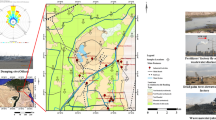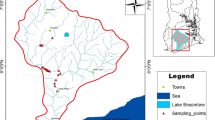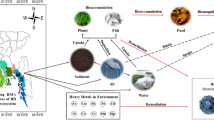Abstract
Lake sedimentation represents a collective record of atmospheric and surface processes operating over the catchment areas. Magnetic minerals along with heavy metal assemblages can selectively represent the ongoing impact of dominant environmental processes over the catchment regions. Lake bottom sediments collected from Anchar Lake were investigated to trace the magnetic and heavy metal signatures in context to quantify the environmental conditions from one of the ideal setup of lake catchment in the Srinagar valley of Kashmir Himalaya. Magnetic parameters such as χARM, SIRM and SoftIRM revealed predominant soft ferrimagnetic mineralogy. The S-ratio showing a mean value of − 0.69 within a range of − 0.77 to − 0.57 depicted majority of PSD-SD ferrimagnetic grains. The χlf versus χfd % biplot suggest the presence of mixture of SP and coarser magnetic grains controlling the magnetic susceptibility signals in the lake bottom sediments. The magnetic parameters and heavy metal constituents in particular S-ratio, SIRM/χlf, χARM/χlf and χARM exhibit significant correlation with Cr, Cu, Ni and Zn. Furthermore, spatial variability of these parameters depicts a complex of detritus influx, anthropogenic inputs, and the domain size of minerals reflecting oxidizing and reducing conditions with sharp changes in the peripheral part and gradual mixing towards the central and deeper parts of the lake basin. Multivariate statistical analyses (Pearson correlation, cluster and factor analyses) attest direct relation of the heavy metals with mineral magnetic assemblages. Overall, the results reflect heterogeneity in the record within the lake basin at the scales of 10’s of meters attributed to basin lacustrine conditions.









Similar content being viewed by others
References
Agarwal KK, Agrawal GK (2005) A Genetic model of thrust bounded intermontane basin using scaled sandbox analogue models: an example from the Karewa Basin, Kashmir Himalayas, India. Int J Earth Sci 94:4752
Agarwal KK, Shah RA, Achyuthan H, Singh DS, Srivastava S, Khan I (2018) Neotectonic activity from Karewa sediments, Kashmir Himalaya, India. Geotectonics 52:88. https://doi.org/10.1134/S0016852118010028
Agrawal DP, Athavale RN, Krishnamurthy RV, Kusumgar S, Murthy CRK, Nautiyal V (1979) Chronostratigraphy of loessic and lacustrine sediments in the Kashmir Valley. Acta Geol Acad Sci Hung 22:185–196
Agrawal DP, Juyal N, Sharma P, Gardner R, Rendell H (1988) Palaeogeography of the loess deposits of Kashmir. Proc Indian Natl Sci Acad 54:383–389
Agrawal DP, Dodia R, Kotlia BS, Razdan H, Sahni A (1989) The Plio-Pleistocene geologic and climatic records of the Kashmir Valley, India: a review and new data. Palaeogeogr Palaeoclimatol Palaeoecol 73:267–286
Anderson NJ, Rippey B (1988) Diagenesis of magnetic minerals in the recent sediments of a eutrophic lake. Limnol Oceanogr 33:1476–1492
Babeesh C, Achyuthan H, Jaiswal MK, Lone A (2017) Late Quaternary loess-like paleosols and pedocomplexes, geochemistry, provenance and source area weathering, Manasbal, Kashmir Valley, India. Geomorphology 284:191–205
Badar B, Romshoo SA, Khan MA (2013) Modelling catchment hydrological responses in a Himalayan Lake as a function of changing land use and land cover. J Earth Syst Sci 2:433–449
Bali R, Agarwal KK, Patil SK, Ali SN, Rastogi SK, Krishna K (2011) Record of Neotectonic Activity in the Pindari Glacier valley: study Based on Glacio geomorphic and AMS Fabric evidences. Earth Sci India 4:1–14
Beckwith PR, Ellish JB, Revitt DM (1986) Heavy metal and magnetic relationships for urban source sediments. Phys Earth Planet Inter 42:67–75
Canbay M (2010) Investigation of the relation between heavy metal contamination of soil and its magnetic susceptibility. Int J Phy Sci 5:393–400
Carver E (1971) Procedures in sedimentary petrology. Wiley, Hoboken, p 653
Dekkers MJ, Passier HF, Schoonen MAA (2000) Magnetic properties of hydrothermally synthesized greigite (Fe3S4)-II. High and low-temperature characteristics. Geophy J Int 141:809–819
Evans ME, Heller F (2003) Environmental magnetism: principles and applications of enviromagnetics. Academic press, Elsevier, Amsterdam, p 299
Fialová H, Maier G, Petrovský E, Kapička A, Boyko T, Scholger R, Team MAGPROX (2006) Magnetic properties of soils from sites with different geological and environmental settings. J Appl Geophy 59:273–283
Foster IDL, Lees JA, Owens PN, Walling DE (1998) Mineral magnetic characterization of sediment sources from an analysis of lake and floodplain sediments in the catchments of the old mill reservoir and Slapton Ley, South Devon, UK. Earth Surf Process land 23:685–703
Hayashida A, Nakano R, Nagashima A, Seto K, Yamada K, Yonenobu H (2015) Magnetic properties of surficial sediments in Lake Ogawara on the Pacific coast of northeastern Japan: spatial variability and correlation with brackish water stratification. Earth Planets Space 67:171. https://doi.org/10.1186/s40623-015-0343-7
Hunt A, Jones J, Oldfeild F (1984) Magnetic measurement and heavy metal in atmospheric particulates on anthropogenic origin. Sci Tot Environ 33:129–139
Jeelani G, Shah AQ (2006) Geochemical characteristics of water and sediment from the Dal Lake, Kashmir Himalaya: constraints on weathering and anthropogenic activity. Environ Geol 50:112–123
Kango RA, Dubey KP, Zutshi D (1987) Sediment chemistry of Kashmir Himalayan lakes: clay mineralogy. Chem Geol 64:21–126
Kaul V (1977) Limnological survey of Kashmir Lakes with reference to trophic status and conservation. Int J Ecol Environ Sci 3:29–44
Kaul V, Trisal CL, Kaul S (1980) Mineral removal. Potential of macrophytes in two lakes of Kashmir. J Indian Botan Soc 55:113–123
Khan JA, Gavali RS, Shouche YS (2012) Exploring present status of Hydrochemistry and Sediment chemistry of Dal Lake, Kashmir and effect of anthropogenic disturbances on it. Indian J Innov Dev 7:554–571
Liu QS, Roberts AP, Larrasoaña JC, Banerjee SK, Guyodo Y, Tauxe L, Oldfield F (2012) Environmental magnetism: principles and applications. Rev Geophys 50:RG4002. https://doi.org/10.1029/2012RG000393
Lone A, Babeesh C, Achyuthan H, Chandra R (2017) Evaluation of environmental status and geochemical assessment of sediments, Manasbal Lake, Kashmir, India. Arab J Geosci 10:1–18
Lu SG, Bai SQ, Xue QF (2007) Magnetic properties as indicators of heavy metals pollution in urban topsoils: a case study from the city of Luoyang, China. Geophys J Int 171:568–580
Ma L, Wu J, Abuduwaili J, Liu W (2016) Geochemical responses to anthropogenic and natural influences in Ebinur Lake Sediments of Arid Northwest China. PLoS ONE 11(5):e0155819. https://doi.org/10.1371/journal.pone.0155819
Meena NK, Maiti S, Shrivastava A (2011) Discrimination between anthropogenic (pollution) and lithogenic magnetic fraction in urban soils (Delhi, India) using environmental magnetism. J Appl Geophys 73:121–129
Mitchell R, Maher BA (2009) Evaluation and application of biomagnetic monitoring of traffic-derived particulate pollution. Atmos Environ 43:2095–2103
Oldfield F, Barnosky C, Leopold EB, Smith JP (1983) Mineral magnetic studies of lake sediments: a brief review. Hydrobiology 103:37–44
Oldfield F, Hunt A, Jones ADH, Chester R, Dearing JD, Olsson L, Prospero JM (1985) Magnetic differentiation of atmospheric dusts. Nature 317:516–518
Sandeep K, Shankar R, Warrier AK, Yadava MG, Ramesh R, Jani RA, Weijian Z, Xuefeng L (2017) A multi-proxy lake sediment record of Indian summer monsoon variability during the Holocene in Southern India. Palaeogeog Palaeoclim Palaeoecol 476:1–14
Shah RA, Achyuthan H, Lone A, Ravichandran R (2017) Diatoms, spatial distribution and physicochemical characteristics of the Wular Lake Sediments, Kashmir Valley, Jammu and Kashmir. J Geol Soc India 90:159–168
Shankar R, Prabhu CN, Warrier AK, Vijaya Kumar GT, Sekar B (2006) A multi-decadal rock magnetic record of monsoonal variations during the past 3700 years from a tropical Indian tank. J Geol Soc India 68:447–459
Sheikh JA, Jeelani G, Gavali RS, Shah AR (2013) Weathering and anthropogenic influences on the water and sediment chemistry of Wular Lake, Kashmir Himalaya. Environ Earth Sci 6:2837–2846
Singh IB (1982) Sedimentation pattern in the Karewa Basin, Kashmir Valley, India, and its geological significance. J Palaeon Soc India 27:71–110
Thompson R, Oldfield F (1986) Environmental magnetism. Allen and Unwin, London
Thompson R, Batterbee RW, O’Sullian PE, Oldfield F (1975) Magnetic susceptibility of lake sediments. Limnol Oceanogr 20:687–698
Thompson RJ, Bloemendal J, Dearing JA, Oldfield F, Rummery TA, Stober JC, Turner GM (1980) Environmental applications of magnetic measurements. Science 207:481–486
Vass KK (1978) On the trophic status and conservation of Kashmir Lakes. Hydrobiol 68:9–15
Walden J, Oldfield F, Smith J (1999) Environmental magnetism- A practical guide. Quaternary Research Association Technical guide No. 6, London, UK
Warrier AK, Shankar R (2009) Geochemical evidence for the use of magnetic susceptibility as a paleo-rainfall proxy in the tropics. Chem Geol 365:553–562
Yang T, Qingsheng L, Qingli Z, Lungsang C (2009) Environmental magnetic responses of urbanization processes: evidence from lake sediments in East Lake, Wuhan, China. Geophys J Int 179:873–886
Acknowledgements
The authors are thankful to the Editor of the journal and the anonymous reviewers for their insightful comments and critical suggestions. Aasif Lone is thankful to Anna University, Chennai, for the Anna Centenary Research Fellowship (ACRF) that enabled him to carry out this work. Aasif Lone and SJS acknowledge the facilities under DST-FIST program and the Head, Department of Geology, SP Pune University, for providing the necessary facilities to carry out the analytical work.
Author information
Authors and Affiliations
Corresponding author
Rights and permissions
About this article
Cite this article
Lone, A.M., Achyuthan, H., Shah, R.A. et al. Environmental Magnetism and Heavy Metal Assemblages in Lake Bottom Sediments, Anchar Lake, Srinagar, NW Himalaya, India. Int J Environ Res 12, 489–502 (2018). https://doi.org/10.1007/s41742-018-0108-9
Received:
Revised:
Accepted:
Published:
Issue Date:
DOI: https://doi.org/10.1007/s41742-018-0108-9




